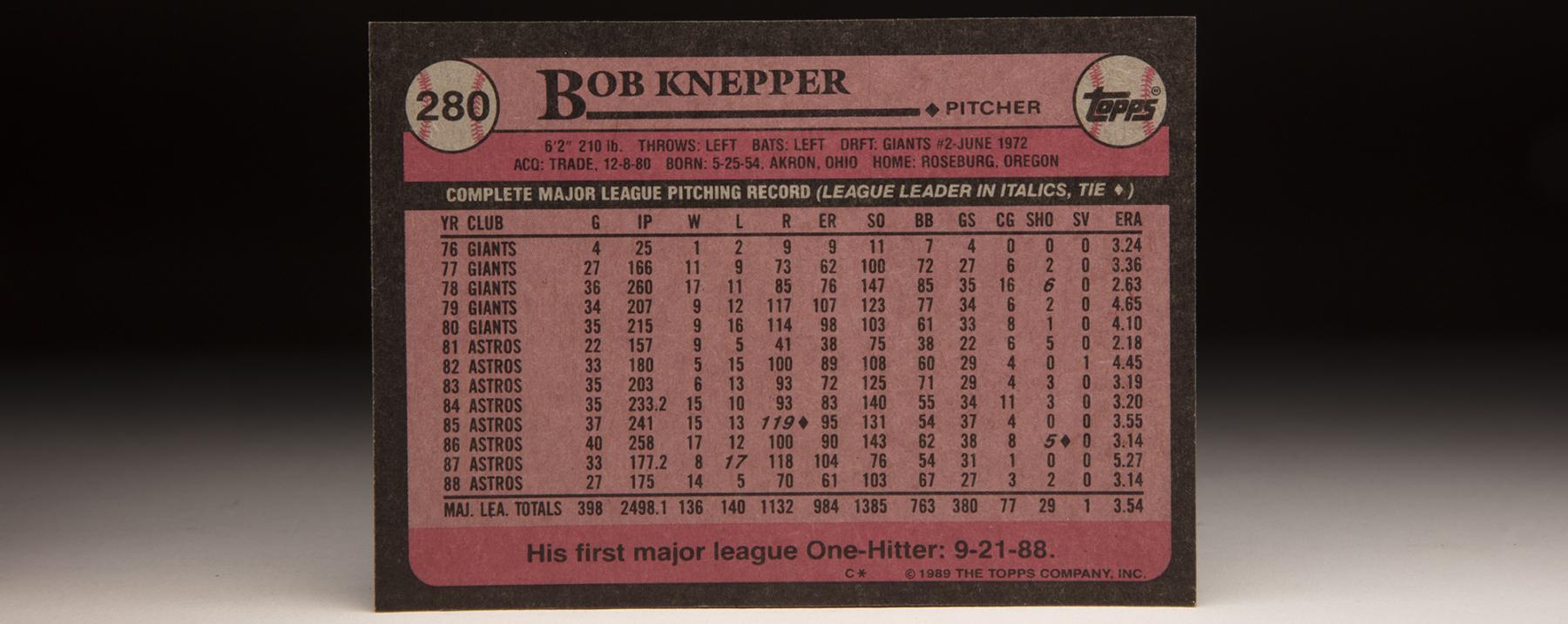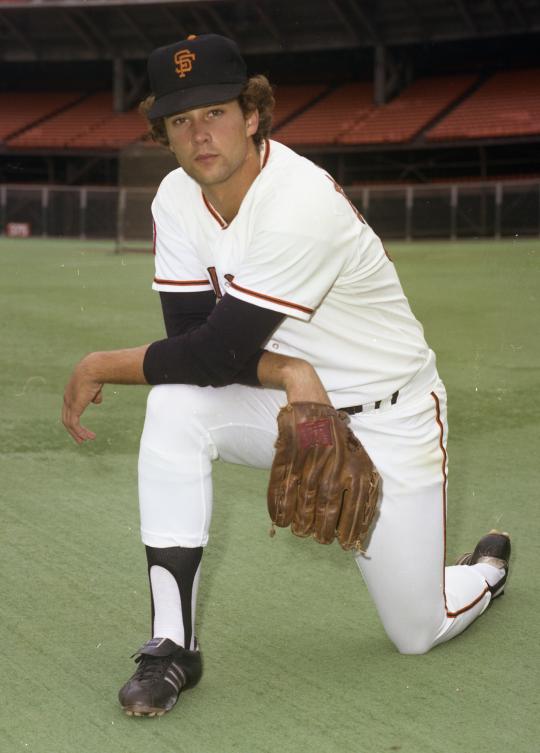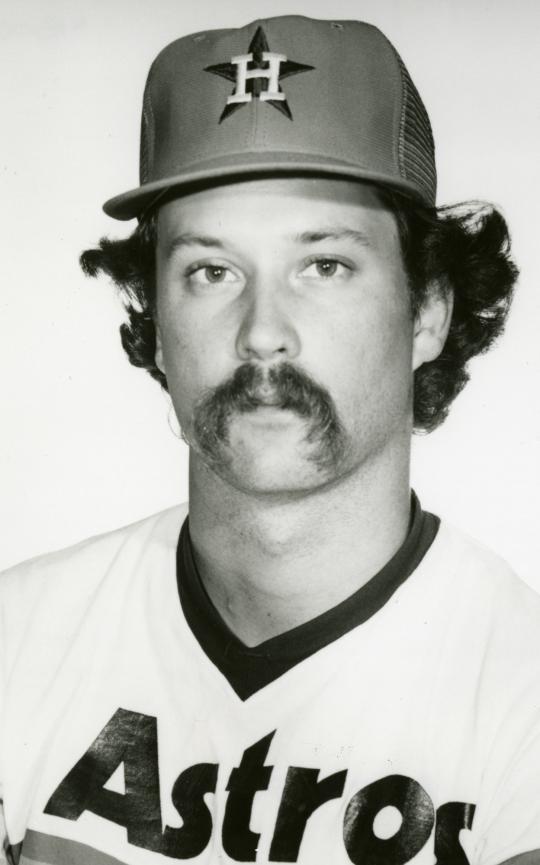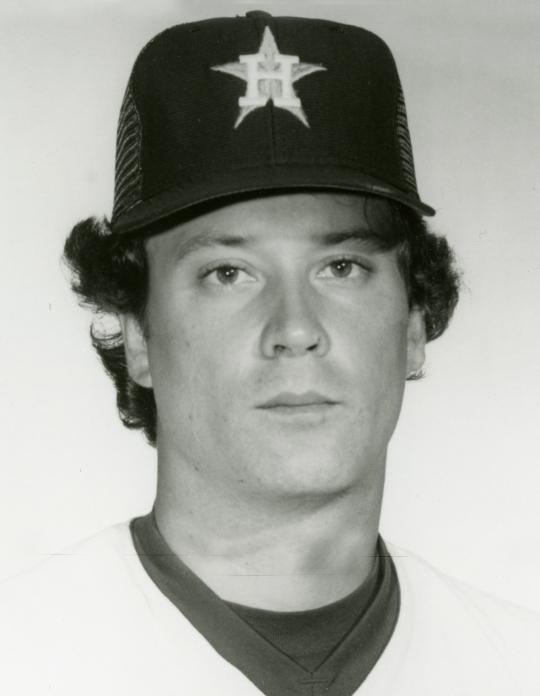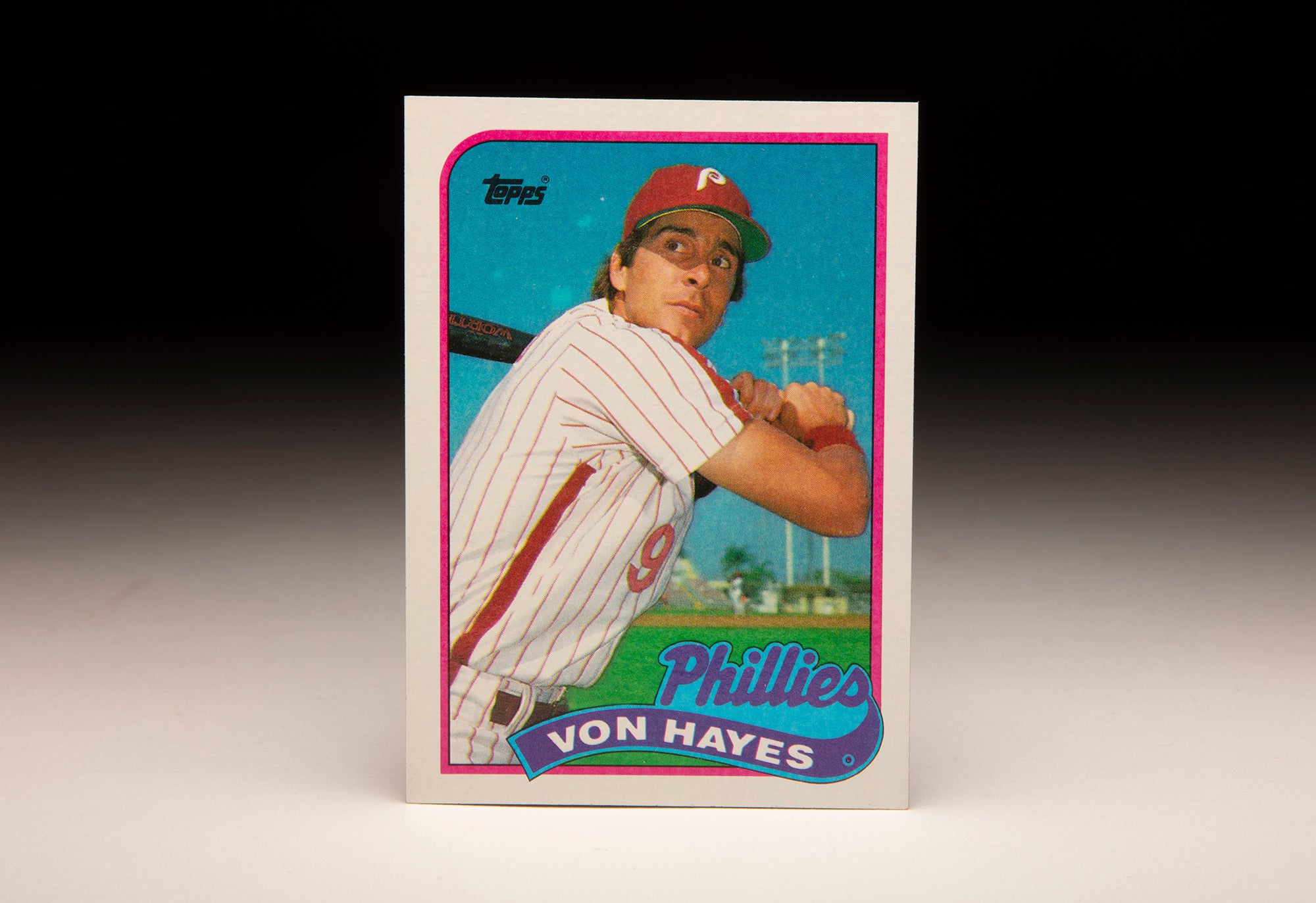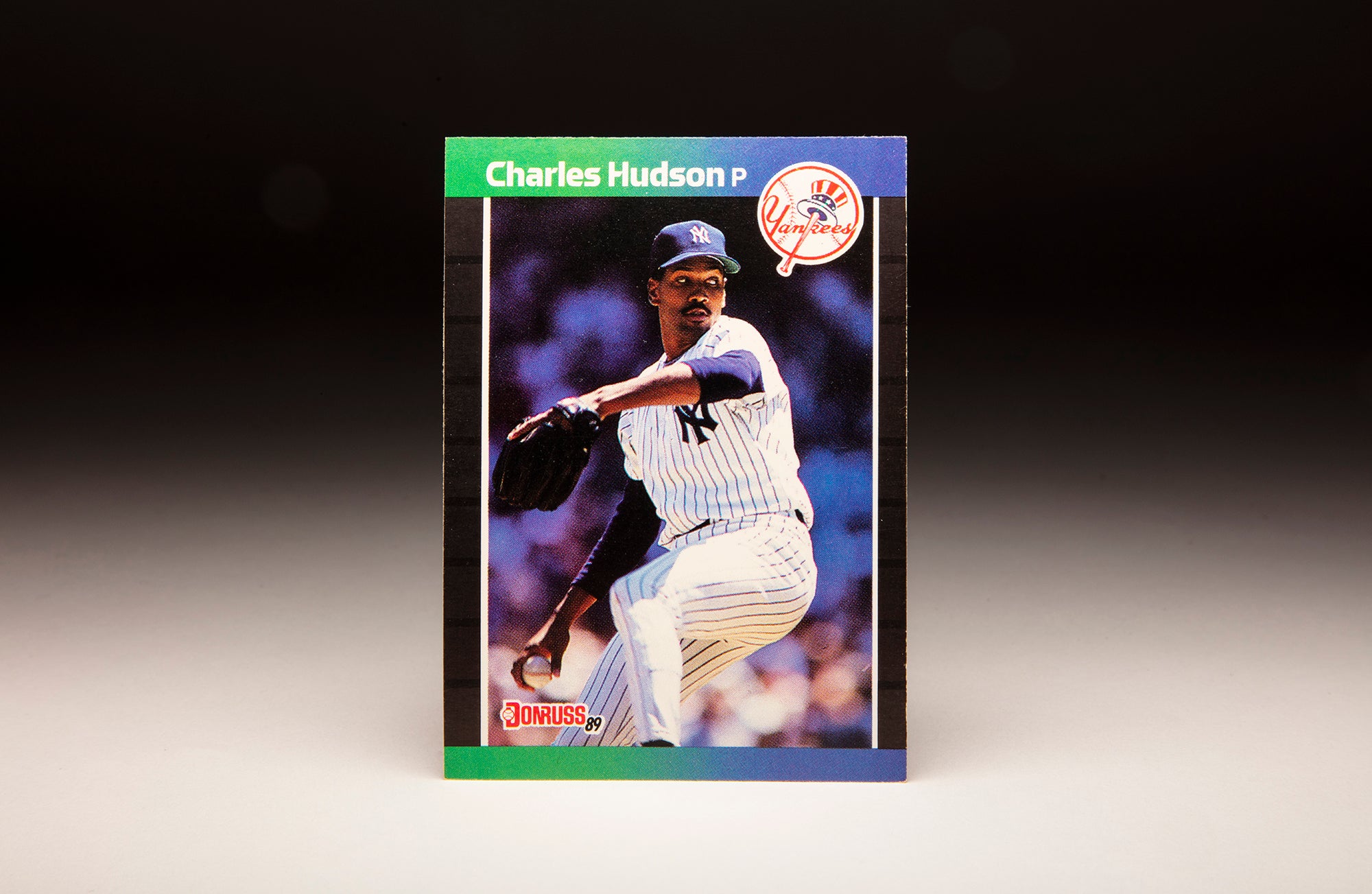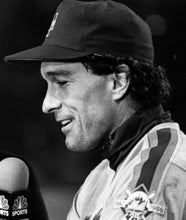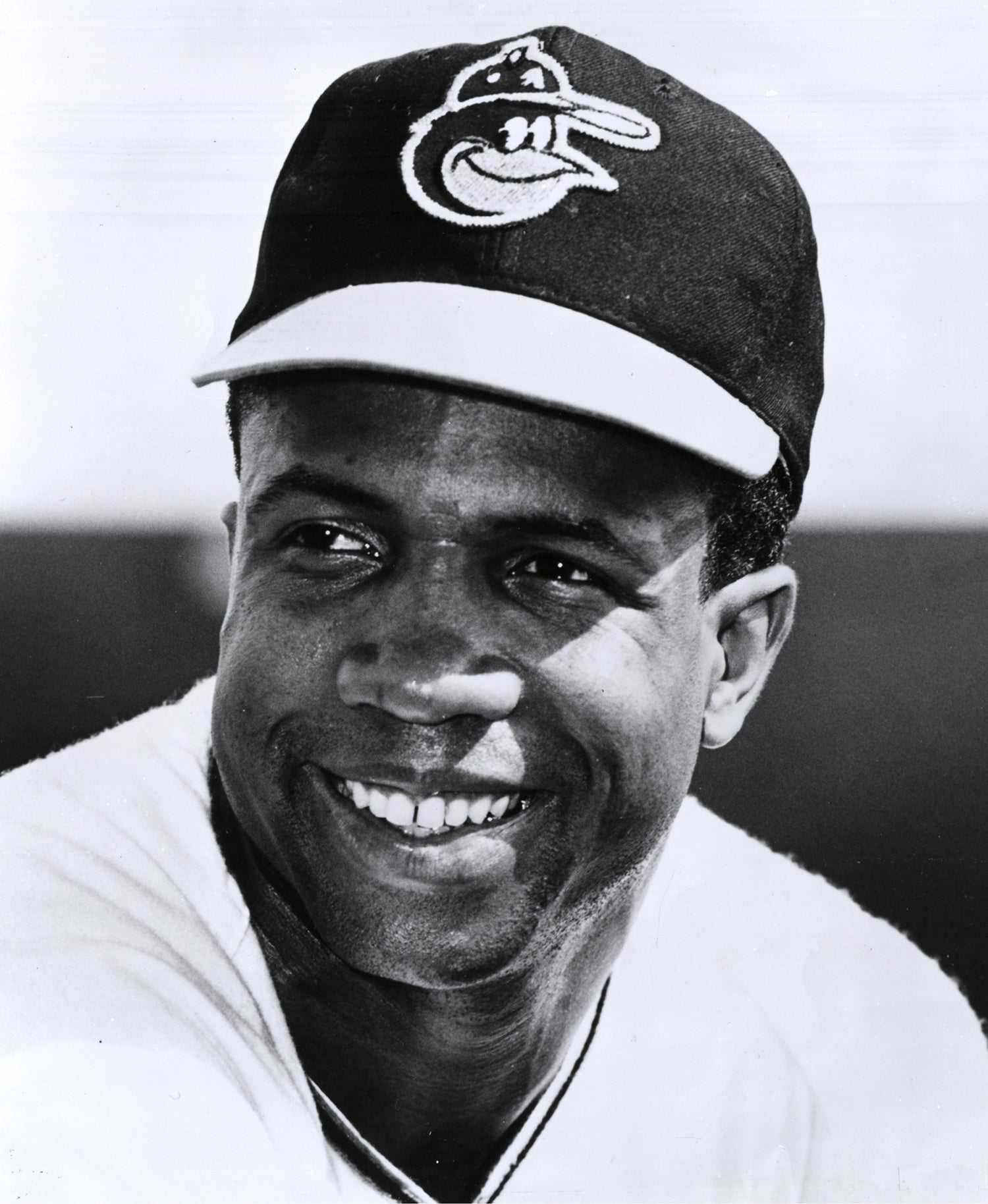- Home
- Our Stories
- #CardCorner: 1989 Topps Bob Knepper
#CardCorner: 1989 Topps Bob Knepper
Bob Knepper authored 30 big league shutouts and won 146 games, meaning more than 20 percent of his victories came when he blanked the opposition.
Few pitchers of his era worked as hard for their success.
Born May 25, 1954, in Akron, Ohio, Knepper moved with his family to the Napa Valley of Northern California when he was growing up. A three-year letter-winner at Calistoga High School, Knepper began attracting scouts during his sophomore year thanks to a 6-foot-3 frame that produced a smooth left-handed delivery.
Official Hall of Fame Merchandise
Hall of Fame Members receive 10% off and FREE standard shipping on all Hall of Fame online store purchases.
Be A Part of Something Greater
There are a few ways our supporters stay involved, from membership and mission support to golf and donor experiences. The greatest moments in baseball history can’t be preserved without your help. Join us today.
Selected in the second round of the 1972 MLB Draft by the Giants – one pick after future 20-game winner Dennis Leonard and four slots in front of another 20-game winner, John Candelaria – Knepper quickly agreed to a contract and was sent to Great Falls of the Pioneer League. There, Knepper went 7-1 with a 1.46 ERA.
“I’ll probably end up in the top Class A league, the California League, at Fresno,” Knepper told the Napa Valley Register during the spring of 1973. “Or maybe in the Double-A Class at (Amarillo) in the Texas League. But the organization is so short of young pitchers that I’ve got a chance at (Triple-A) Phoenix.”
Knepper did end up at Fresno after initially being assigned to Decatur of the Midwest League, where he went 7-2 with a 1.94 ERA in 11 starts. He struggled at Fresno after being promoted but returned there in 1974, where he was 20-5 with a 3.18 ERA in 30 starts.
A unanimous all-league selection, Knepper became the California League’s first 20-game winner since Bruce Gardner in 1961.
“I haven’t slept too well the past three days,” Knepper told the Fresno Bee after winning his 20th game on Aug. 28. “I wanted this win very much.”
Knepper earned an invitation to the Giants big league Spring Training camp in 1975 and pitched well enough to merit consideration to go north for the season before the flu sidelined him late in camp, opening the door for another young hurler: Pete Falcone.
Knepper, meanwhile, was assigned to Triple-A Phoenix before turning 21 years of age.
“I’m happy about not having to play Double-A ball,” Knepper told the Arizona Republic. “I’m looking forward to pitching (with Triple-A Phoenix).”
But the jump proved a difficult one as Knepper went 11-11 with a 4.59 ERA in 26 starts.
“There’s no question he has big league stuff,” Giants minor league pitching instructor Frank Funk told the Republic. “He just needs to acquire consistency.”
Back at Triple-A in 1976, Knepper went 14-10 with a 4.30 ERA in 205 innings, earning a September call-up to the Giants. He debuted on Sept. 10 against the Reds, allowing two runs over seven innings while being tagged with a hard-luck loss against the eventual World Series champions.
That same day, Knepper’s father Adrian, a teacher at Calistoga High School, suffered a heart attack. Knepper was unaware until after the game.
“That’s what my father wanted,” Knepper told the Press Democrat of Santa Rosa, Calif.
Knepper started three more games that September, finishing 1-2 with a 3.24 ERA after picking up his first win Sept. 28 against the Braves.
Knepper was disappointed not to make the Giants’ Opening Day roster in 1977, and he began the season in a slump with Triple-A Phoenix. He was 3-6 with a 7.41 ERA in 10 appearances in late May. But he won his final start – and told manager Rocky Bridges that good things were about to happen.
“It was a terrible night,” Knepper told the Napa Valley Register of his start in Spokane, Wash., “but we won the game by one run and in the locker room afterwards I told Rocky Bridges I was ready to move up to the big club. We all laughed.
“The next morning about nine o’clock I got the call.”
Knepper’s break came when John Montefusco injured his ankle and the Giants needed a starting pitcher. Knepper took advantage, overcoming two shaky appearances by limiting the Pirates to one run over 8.1 innings in a 3-1 win on June 6. He tossed a shutout against the Pirates 13 days later and notched decisions in 18 of his final 20 starts, finishing the season with a mark of 11-9 and a 3.36 ERA.
Now firmly established in the Giants’ rotation, Knepper led San Francisco with 260 innings pitched in 1978 while going 17-11 with a 2.63 ERA that was buoyed by an NL-best six shutouts.
On March 25, 1979, the Giants signed Knepper to a three-year deal worth $450,000.
“My lifetime desire was to belong to a class organization,” Knepper told the Sacramento Bee on the eve of the 1979 season. “And I’m with one. I don’t want to leave here.”
Knepper also became a Christian in 1978 and relied on his faith during the 1979 season, when his son was born five weeks premature. Coupled with a sore arm, the stress of worrying about his son – who ultimately grew stronger – left Knepper with a 9-12 record and 4.64 ERA in 34 starts.
Knepper earned the Opening Day start for the Giants in 1980 but clashed with manager Dave Bristol and the media over his beliefs, worried about his mechanics and ended the year 9-16 with a 4.10 ERA.
“The one thing that I’ve always told Bob Knepper was: ‘Always be aggressive. Believe in your fastball,’” Bristol told the Sacramento Bee. “He has to start to believe.”
But neither Bristol nor Knepper would see the results of that advice. Bristol was replaced by Frank Robinson following the 1980 season and Knepper and Chris Bourjos were sent to the Astros on Dec. 8 in exchange for Enos Cabell.
“Before the trade to Houston, I questioned whether I wanted to play ball anymore,” Knepper told the Napa Valley Register in the spring of 1981. “It got so bad last year that I didn’t like going to the ballpark. I didn’t have freedom of religion, or almost freedom of speech. (But) I’m looking forward to playing in Houston. It’s nice to have a fresh start.”
Knepper parlayed that fresh start into one of the best stretches of his career. He posted shutouts in three of his first five outings in 1981 and was working on a 5-1 record and 1.15 ERA when the strike interrupted the season in June. Named to his first All-Star Game, Knepper pitched two scoreless innings in the Midsummer Classic and finished the year 9-5 with a 2.18 ERA in 22 starts.
The Astros won the second half NL East title and advanced to the NLDS vs. the Dodgers, where they won the first two games before sending Knepper to the mound for Game 3. But Los Angeles scored three runs in the first off Knepper, who settled down to allow just those three runs over five innings but took the loss. The Dodgers won the next two games to advance to the NLCS.
With his contract expired, Knepper agreed to a four-year, $2 million deal with Houston in January of 1982 as the Astros assembled what was called the “$21 million pitching staff” with the likes of Nolan Ryan, Joe Niekro and Don Sutton. But Houston won just 77 games that year as Knepper went 5-15 with a 4.45 ERA.
After going 6-13 – albeit with a much better 3.19 ERA – in 203 innings in 1983, Knepper was unsure of what the 1984 season would bring.
“The general manager (Al Rosen) wants me, but the owner (John McMullen) doesn’t,” Knepper, whose name had been bandied about in trade rumors during the offseason, told the Associated Press in the spring of 1984.
Rosen ended up winning the battle – and McMullen reaped the benefits. Knepper went 15-10 with a 3.20 ERA in 233.2 innings in 1984 before signing a new three-year deal in the spring of 1985. That year, he went 15-13 with a 3.55 ERA over 241 innings.
“The biggest change,” Knepper told the Bee, “was recognizing the ability I’ve been blessed with. I didn’t see any reason why I couldn’t be a superstar pitcher.”
In 1986, Knepper pitched like a superstar – winning his 10th game on June 10 and helping the Astros grab control of the NL West. He endured a summer slump but still finished 17-12 with a 3.14 ERA and an NL-best five shutouts as Houston won the division title.
Knepper started Game 3 of the NLCS vs. the Mets and allowed three earned runs over seven innings, earning a no decision in a game New York won 6-5 when Lenny Dykstra’s two-run home run off reliever Dave Smith in the bottom of the ninth proved to be the difference.
Then in Game 6, Knepper got the ball again with the Mets leading the series 3-games-to-2 but with ace Mike Scott waiting in the wings to pitch for Houston in Game 7. Knepper carried a 3-0 lead into the ninth having faced the minimum 15 batters through the fourth through eighth innings. But in the ninth, Knepper allowed a triple, single and double while recording only one out before Smith again came on in relief with the Astros clinging to a 3-2 lead.
Smith issued walks to Gary Carter and Darryl Strawberry to load the bases before Ray Knight’s sacrifice fly tied the game. The Mets would go on to win in 16 innings in one of the most thrilling postseason contests in history.
“During the 10th, 11th, 12th and 13th innings, I was thinking that none of this would have been necessary if I had done my job,” Knepper told the Associated Press. “We’d be out there tomorrow.”
Knepper and the Astros struggled to recapture the magic in 1987, as Knepper began the season 3-12. He finished the year 8-17 – the most losses in the NL – with a 5.27 ERA.
“I worked so hard between starts trying to figure out what was wrong,” Knepper told the Associated Press. “But nothing seemed to work. I appreciate it that (Astros manager) Hal (Lanier) stayed with me.”
Knepper bounced back in 1988, winning his first six decisions. But he attracted unwanted attention during the spring when he told reporters that he disapproved of female umpire Pam Postema, who was working a Spring Training game that Knepper was pitching. Knepper was not critical of Postema’s work but rather he role as a working woman.
“What’s happened is that women are losing the lofty place they had in our society,” Knepper told the Chicago Tribune. “They want to be treated like men. They want to be one of the boys. But they can’t be one of the boys.”
Knepper managed to ignore the resulting criticism and posted a 14-5 record and 3.14 ERA in 1988, earning his second All-Star Game selection. But in 1989, Knepper was 4-10 with a 5.89 ERA when the Astros released him on July 28. He signed with the Giants a week later and worked effectively as a swingman down the stretch, helping San Francisco win the NL West while going 3-2 with a 3.46 ERA over 52 innings, spinning a shutout against the Mets on Aug. 22. It would be the 30th-and-final shutout of Knepper’s career.
After not pitching in the NLCS or World Series, Knepper found few suitors in free agency and returned to the Giants on a minor league deal that spring. After four starts in Triple-A Phoenix – where he had not pitched since 1977 – Knepper was called up to the Giants, where he went 3-3 with a 5.68 ERA before being released on June 26. He would not pitch in the big leagues again.
Knepper finished his career with a 146-155 record, a 3.68 ERA and 78 complete games. Not many pitchers alternated good seasons with bad as frequently as Knepper, but his even-keeled demeanor made it possible for him to weather the storm and wait for better days.
“You can’t let yourself think about the people at home and letting them down, or think about getting sent back to the minors,” Knepper told the Napa Valley Register after the 1977 season. “If I pitched a bad game, so what? I’ll come back.”
Craig Muder is the director of communications for the National Baseball Hall of Fame and Museum


